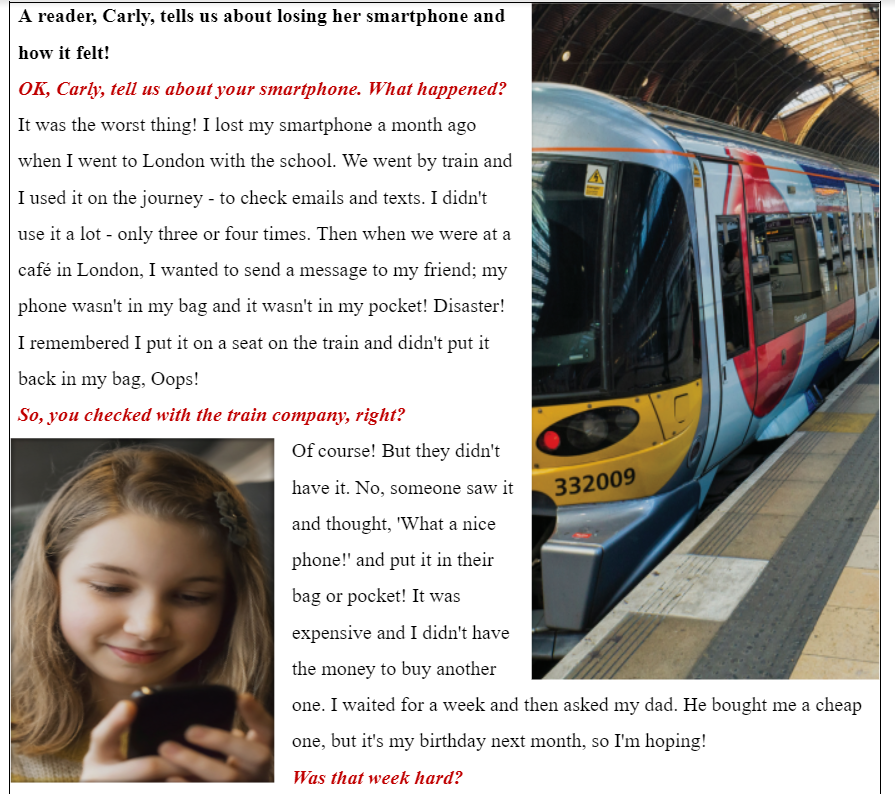5. Read the passage and choose the correct answer to each question (1.0 pt)
(Đọc bài đọc và chọn đáp án đúng cho từng câu hỏi)
When you’re using electricity, think about where it comes from and how you can use less to save the environment. Here are some simple ways to save energy:
• On or Off ?
Leaving televisions and computers on standby with the little red light showing still uses up electricity, even though they might look like they’re turned off. To stop this you can turn them off.
• Lights out!
Turning lights off when you’re not in the room can save a lot of energy.
• Shopping
Many products are now helping you to reduce your energy use and your parents’ energy bills! Check new products for their efficiency grade and rating. Keep an eye out for the “Energy Efficiency Recommended” logo.
• In the Refrigerator
The fridge is an important part of the kitchen. It keeps food fresh, cool and healthy! But it takes a lot of energy to keep cool, so help it by not leaving the fridge door open or putting hot things inside.
1. This passage tells you _________.
A. how to keep the environment clean
B. some ways to save energy
C. some kinds of electrical appliances
2. When you leave televisions and computers on standby, _________.
A. they still use electricity
B. they are turned off
C. you can save energy
3. When you go out of the room, you should _______.
A. close the door
B. turn on the lights
C. switch off the lights
4. Why should you choose products with the “Energy Efficiency Recommended” logo?
A. Because they use more electricity.
B. Because they are new products.
C. Because they are more economical.
5. Putting hot things in the fridge ________.
A. can save a lot of energy
B. is not a good thing to do
C. is a quick way to keep cool
Dịch bài đọc:
Khi bạn đang sử dụng điện, hãy nghĩ xem nguồn điện đó đến từ đâu và làm thế nào bạn có thể sử dụng ít điện hơn để tiết kiệm môi trường. Dưới đây là một số cách đơn giản để tiết kiệm năng lượng:
• Bật hay tắt?
Để ti vi và máy tính ở chế độ chờ với một chút đèn đỏ hiển thị vẫn sử dụng hết điện, mặc dù chúng có vẻ như đã tắt. Để dừng điều này, bạn có thể tắt chúng.
• Tắt đèn!
Tắt đèn khi bạn không ở trong phòng có thể tiết kiệm rất nhiều năng lượng.
• Mua sắm
Nhiều sản phẩm hiện đang giúp bạn giảm mức sử dụng năng lượng của mình và của bố mẹ bạn! Kiểm tra các sản phẩm mới để biết cấp hiệu quả và xếp hạng của chúng. Hãy để ý đến biểu tượng “Khuyến nghị sử dụng năng lượng hiệu quả”.
• Bên trong tủ lạnh
Tủ lạnh là một phần quan trọng của nhà bếp. Nó giữ cho thực phẩm tươi, mát và tốt cho sức khỏe! Nhưng cần rất nhiều năng lượng để giữ mát, vì vậy hãy giúp nó bằng cách không để cửa tủ lạnh mở hoặc cho đồ nóng vào bên trong.
|
1. B |
2. A |
3. C |
4. C |
5. B |

Các bài tập cùng chuyên đề
1. Listen and read.
(Lắng nghe và lặp lại.)
At an International Robot Show
Nick: Dr Adams! Can you tell us about the robots in the show, please?
Dr Adams: Sure. This is H8, a home robot. It can do the dishes, iron clothes, put toys away...
Nick: It looks very useful!
Dr Adams: Yes, it can even make meals.
Phong: Look! That's the biggest robot in the show.
Dr Adams: Right, it's WB2, a worker robot, it's the strongest and faster robot here.
Nick: What can it do?
Dr Adams: It can move heavy things or repair broken machines.
Nick: And what is this?
Dr Adams: It's Shifa, a doctor robot. It's the smartest robot. It can help sich people and do many things like humans.
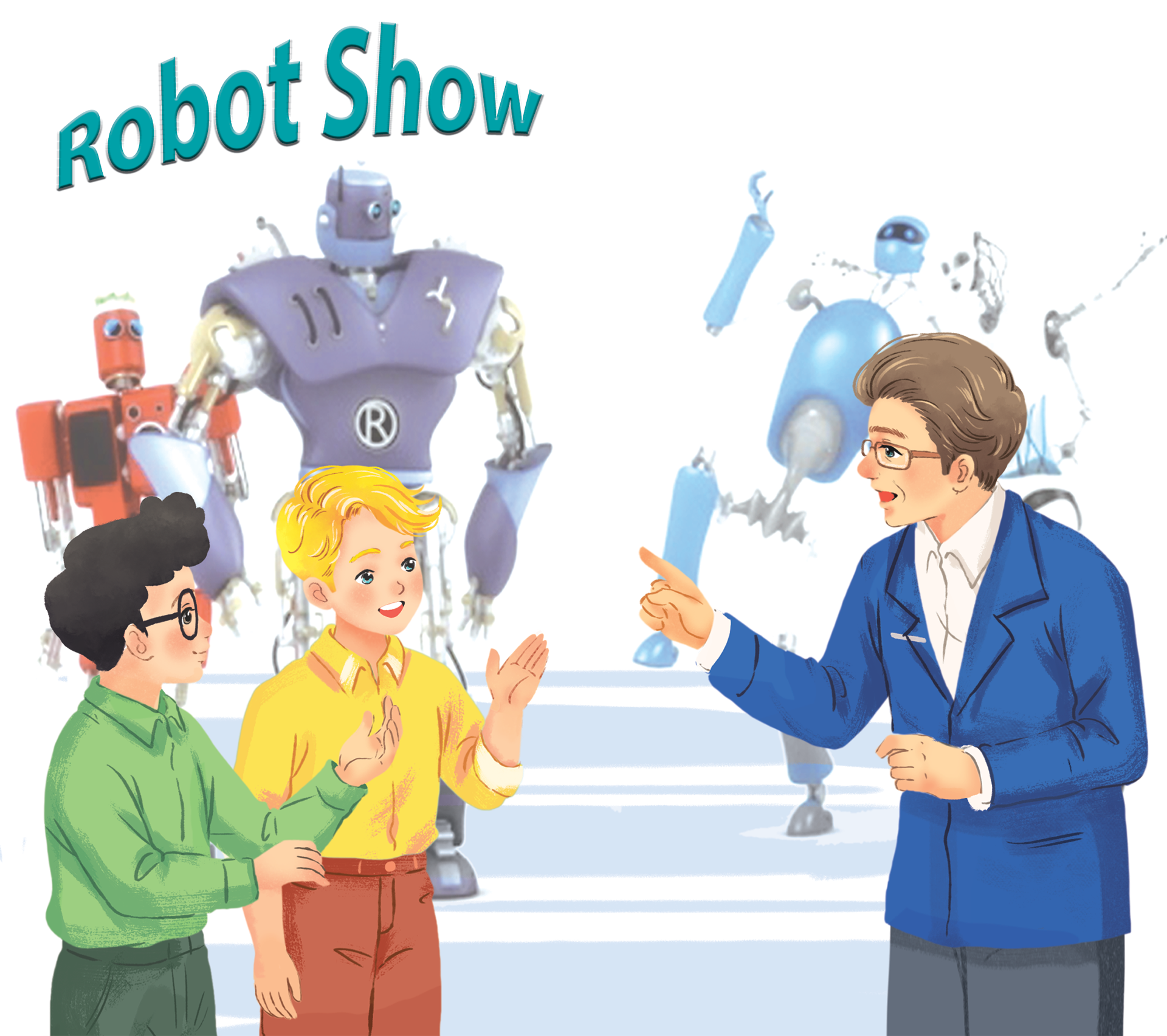
2. Read the conversation and tick (✓ ) T (True) or F (False).
(Đọc bài hội thoại và đánh dấu (✓ ) T (Đúng) hoặc F (Sai).)
|
|
T |
F |
|
1. H8 is a very useful robot. (H8 là một robot rất hữu ích.) 2. WB2 can't repair broken machines. (WB2 không thể sửa chữa máy bị hỏng.) 3. Shifa is a doctor robot. (Shifa là một robot bác sĩ.) 4. H8 is the fastest in the robot show. (H8 nhanh nhất trong triển lãm robot.) 5. Shifa is very smart. (Shifa rất thông minh.) |
|
|
2. Read the text and choose the best answer to each of the questions.
(Đọc văn bản và chọn câu trả lời đúng nhất cho mỗi câu hỏi.)
Today there is an international robot show in Ha Noi. People can see many types of robots there.
Home robots are useful for housework. They can do most of the housework: cook meals, clean the house, do the washing, and iron clothes.
Teacher robots are the best choice for children. They can help them to study. They can teach them English, literature, maths and other subjects. They can also help children to improve their English pronunciation.
People are also interested in other types of robots at the show. Worker robots can build houses and move heavy things: doctor robots can look after sick people and space robots can build space stations on the Moon and on planets.
1. What show is on Ha Noi now?
A. A fashion show
B. A robot show
C. A pet show
2. Which type of robots can help children in their study?
A. Home robots
B. Worker robots
C. Teacher robots
3. Doctor robots can ___________.
A. help children to study
B. build houses
C. take care of sick people
4. Which of the following sentences is NOT true according to the passage?
A. Worker robots can build houses and move heavy things.
B. Space robots can build space Stations on the Moon.
C. Home robots can't do much of the housework.
3. Read the text again and fill the table below.
(Đọc văn bản một lần nữa và điền vào bảng dưới đây.)
|
Types of robots |
What they can do |
|
Home robots |
cook meals,... |
|
Teacher Robots |
|
|
Worker robots |
|
|
Doctor robots |
|
|
Space robots |
|
Choose the best answer
My future robot will be able to help me do the ___________.
-
A.
garden
-
B.
gardens
-
C.
gardening
-
D.
gardened
2. Check if you understand the words below. Then listen and read the article and choose the best title.
(Kiểm tra xem các em có hiểu các từ dưới đây hay không. Rồi nghe và đọc bài báo để chọn tiêu đề tốt nhất cho bài.)
|
candle experiment take part |
A. The worst month of my life
(Tháng tồi tệ nhất trong cuộc đời tôi)
B. A schoolgirl's dream comes true
(Giấc mơ của một nữ sinh trở thành hiện thực)
C. We don't know how lucky we are!
(Chúng ta không biết chúng ta may mắn như thế nào!)
Last month Birmingham schoolgirl Becky Carter and her family took part in The Big Switch Off, an experiment to live without electricity for a month. Becky talked to us about the experiment.
Q: Was it difficult to live without electricity?
A: No, not really - it was fun! Sometimes we all played cards. My sister and I gave little concerts - we played the guitars. Often we just sat with candles and read or talked. We also went to the cinema a lot! But it was a bit hard without the internet at home. At the beginning I used my phone but then the battery died and I couldn't use my charger!
Q: What were the best things?
A: It was cool to eat together at the table every day. Before The Big Switch off we always had dinner in front of the TV.
Q: What were the lessons you learned from the experiment?
A: First, it's great we have a gas cooker! Most important, I learned that electricity is awesome! Man lived for hundreds of thousands of years without electricity - we're lucky to have it.
3. Read the text again. Mark the sentences ✓ (right), x (wrong), or ? (doesn't say).
(Đọc lại văn bản. Đánh dấu câu ✓ (đúng), x (sai), hoặc ? (không đề cập đến).)
|
|
1. Only people from Birmingham took part in The Big Switch Off. |
|
|
2. Becky played a musical instrument with her sister. |
|
|
3. It was quite difficult for Becky to live without the Internet. |
|
|
4. The Carters often ate at the table before the experiment. |
|
|
5. The Carters couldn't cook during The Big Switch Off. |
4. Study the Vocabulary box. In pairs, find the things in the box that.
(Nghiên cứu khung từ vựng. Theo cặp, tìm các món đồ trong bảng đó.)
1. Becky talks about in the article.
(Becky nói về trong bài báo.)
2. You usually find in the kitchen/bathroom.
(Bạn thường thấy trong nhà bếp / phòng tắm.)
3. You think are most useful.
(Bạn nghĩ là hữu ích nhất.)
|
Vocabulary |
Everyday technology 1 (Công nghệ mỗi ngày) |
|
charger (sạc) cooker (bếp) electric toothbrush (bàn chải đánh răng điện tử) fridge (tủ lạnh) kettle (ấm đun nước) washing machine (máy giặt) |
|
1. In pairs, look at the webpage. How many of the things/people from the noughties do you know?
(Theo cặp, các em hạy nhìn vào trang web. Bao nhiêu người, vật dụng từ trang web noughties mà em biết?)
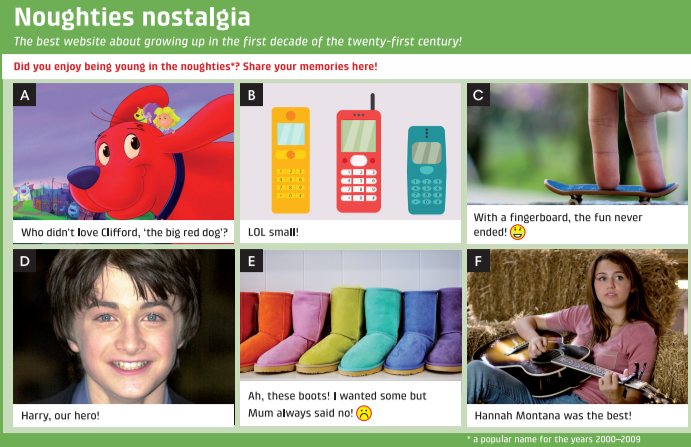
1. Read or listen to Part 1 of the conversation between Max, Eva and their dad. Who is is/isnt’t a fan of smartphone?
(Đọc hoặc nghe phần 1 đoạn hội thoại giữa Max, Eva và cha của họ. Ai là hoặc không phải là fan của điện thoại thông minh.)
Max, Dad and Eva are having a picnic. They are discussing the pros and cons of smart phones.
Dad: You're not listening to me - you're checking your phones! People don't talk or listen any more - they just check their phones.
Eva: That's not fair! We are listening. You can have a conversation and check your phone at the same time.
Dad: Sorry, but I disagree. It's rude. Smartphones are terrible. They're bad for your eyes and the microwaves can't be good for your brain.
Max: Maybe you're right, but smartphones are really useful for checking information. Train times, for example. Remember when you could only get information at the station? It was a pain in the neck!
Eva: l agree. Smartphones are great. And a phone is more than a phone. It's an alarm clock, an MP3 player, an address book, a camera...
Dad: That's true, but I still think smartphones are dangerous. People don't look where they're going because they look at their smartphones all the time. Max! You're looking at your phone again!
2. In pairs, read the emails and answer the questions.
(Theo cặp, các em đọc thư điện tử và trả lời các câu hỏi sau.)
|
Hi Lily, How are you? I tried to phone but there was no answer. Did your first exam go OK? Grandma came to stay yesterday. This morning we went to Rochester Castle. Then we had lunch in a restaurant next to the river. The castle was boring but lunch was nice! After that Grandma bought me two T-shirts for my birthday. Lucky me! Guess what! I asked Grandma about Dad's job at the gas station. She said that he lost his job after only three days because he was late for work every morning! Phone me! Lots of love, Max XXX |
1. Who wrote the emails?
(Ai đã viết thư điện tử?)
2. Who did he write to? Why?
(Anh ấy đã viết cho ai? Vì sao?)
3. Who is staying with Max and his dad at the moment?
(Hiện tại ai đang ở cùng với Max và bố bạn ấy?)
2. Read the texts on the website and put the ideas on this timeline. In pairs, say which idea you think is the most important.
(Đọc các văn bản trên trang web và đưa ra các ý tưởng trên dòng thời gian này. Theo cặp, hãy nói ý tưởng nào bạn cho là quan trọng nhất.)

1. Read the article above. Match pictures A-D with paragraph 1-4.
(Đọc bài báo trên. Ghép hình ảnh A-D với đoạn văn 1-4.)
1. The hot-air balloon was the first form of flying that carried people. The first passengers were a sheep, a duck and a chicken! Then a few weeks later, on 21 November 1783 in France, a balloon carried two people.
2. The hot-air balloon uses science in a very easy but clever way. Hot air rises in colder air because it is lighter and less dense, just like the way our body floats on water.
3. The hot-air balloon has three main parts. There is a balloon envelope - this holds the air. At the top, there is a valve. Under the envelope, there is a burner. This uses propane gas to heat the air in the balloon. There is a wicker basket to carry passengers.
4. When the pilot wants the balloon to go higher, he turns up the gas to make the air hotter. To go down, he opens the valve at the top of the balloon. Some hot air leaves the balloon and it goes down.
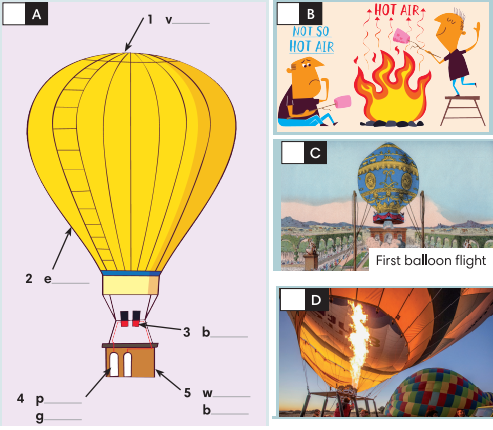
3. Read the article again. Answer the questions.
(Đọc lại bài báo. Trả lời các câu hỏi.)
1. Who were the first passenger in a hot-air balloon?
(Ai là hành khách đầu tiên trên khinh khí cầu?)
2. When did the first hot-air balloon carry people?
(Khinh khí cầu đầu tiên chở người khi nào?)
3. Why do hot-air balloons have wicker baskets?
(Tại sao khinh khí cầu có giỏ đan bằng mây?)
4. How do hot-air balloons go down?
(Làm thế nào để khinh khí cầu đi xuống?)
Read and choose the best answer to complete the passage
I have had my robot (1)____ 3 years now, and it has helped me enormously with my schoolwork. I was unable (2)______ to school because I have a health condition. So the government has provided me with a small robot which I can send to school in my place. The robot transmits information to me in real time. It asks and responds to questions from teachers, can move freely around the school, and it even interacts (3) _________ my classmates. I am really happy with it and my grades have improved dramatically since I have had it.
Although it was pretty difficult to use the robot at (4)_________, I realize I am really lucky to have him. I am reading in the paper the other day that a lot of kids want robots to learn or play with, or help them with their chores. I believe a lot more people (5) _________ robots in the future.
1. Read the conversation between an interviewer and Dr Brown, a robot expert. Tick T (True) or F (False)
(Đọc đoạn hội thoại giữa một người phỏng vấn và ông Brown, một chuyên gia robot. Tích Đúng hoặc Sai)
- Interviewer: Good morning, Dr Brown. Welcome to our programme.
- Dr Brown: Good morning.
- Interviewer: Could you tell us what robots can do now, please?
- Dr Brown: Well, they can do a lot of things in many fields now. But they can’t understand our feelings or can’t do quite a lot of complicated things.
- Interviewer: What can home robots do for us in our houses?
- Dr Brown: A lot. They can work as guards in your house and even look after your babies when you’re away.
- Interviewer: Great! Can they do more complicated things like play football or drive a car?
- Dr Brown: They can’t play football now but they can drive a car only in streets with few vehicles.
- Interviewer: Really? Can they talk to humans?
- Dr Brown: Yes. The smartest robots can understand and speak more than 30 languages.
|
T |
F |
|
|
1. Robots can understand our feelings. |
||
|
2. Home robots can do a lot of things in our houses. |
||
|
3. Robots cannot play football. |
||
|
4. Robots can drive a car in every street. |
||
|
5. Robots can talk to people. |
2. Mark Huge, a robot expert, is now online answering questions from Sarah, Jeremy and Nubira about the story and design of robots. Read his blog and choose the correct answer A, B, C or D for each gap
(Mark Huge, một chuyên gia robot, đang online để trả lời các câu hỏi từ Sarah, Jeremy và Nubira về câu chuyện và thiết kế của robot. Đọc blog của ông ấy và chọn đáp án đúng)
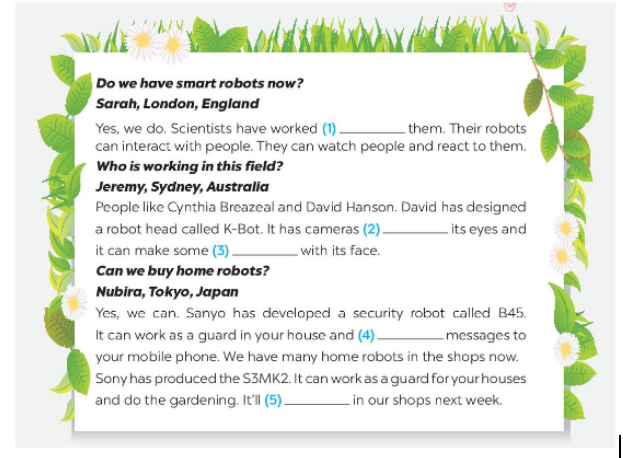
1. A. on B. in C. at D. to
2. A. on B. into C. in D. to
3. A. looks B. feelings C. expressions D. shows
4. A. bring B. take C. pass D. send
5. A. appear B. go C. have D. buy
3. Read the text and choose the correct answer (A, B, C, or D) for each of the questions from 1 to 5
(Đọc văn bản và chọn đáp án đúng cho mỗi câu hỏi từ 1 đến 5)
A robot cannot think or do things alone. People use a computer to control it. Today, robots are becoming useful in our lives. They can help us to save a lot of time and work. A robot can do the same work for 24 hours, and yet, it does not complain or get tired. In the US, people use robots as security guards in some important places. These robots can listen for certain noises and send signals for help if there’s trouble or danger. In Japan, people use robots in factories to build cars. In the future, scientists will design many types of intelligent robots. Their robots will help us do many more complicated things. However, some people do not like robots. They fear that one day robots will be too powerful.
1. Why do people use a computer to control a robot?
A. Because it can save time and work.
B. Because it cannot think or do things alone.
C. Because it is too expensive.
D. Because it is very useful.
2. Which of the following statements is NOT TRUE according to the text?
A. People use computers to control robots.
B. Robots cannot do the same work for 24 hours.
C. Robots do not get tired of working.
D. People use robots as security guards in some important places in the US.
3. The word “it” in the text refers to __________.
A. a robot
B. a computer
C. work
D. the US
4. In Japan, people use robots in factories to __________.
A. guard important places
B. do many more complicated things
C. build cars
D. listen to certain noises
5. Some people fear that one day robots __________.
A. will be busier than humans
B. will do complicated things
C. will have too much power
D. will make too much noise
4. Put a suitable word in each blank to complete the letter (2.0 pts)
(Đặt từ phù hợp vào mỗi chỗ trống để hoàn thành bức thư)
Hello Kitty,
I am now at the robot show. I am surprised to (1)_____ so many kinds of robots. They (2)______ of different sizes! The (3)______ one is only 20 centimetres long, but the biggest is 10 metres tall! I am interested (4)______ Robot Kiku. It can talk (5)_______ me in English. My mum likes the robot that can cook and (6)______ the dishes. My sister loves Homy as it can (7)______ all the housework. Now I want a robot that can answer all my (8)______. And I hope in the future more people (9)______ have robots at home, and we won’t (10)_____ to school because a robot will teach us everything.
Your friend,
Nghia Phan
7. Complete the blog with one word in each gap.
(Hoàn thành blog với một từ trong mỗi khoảng trống.)
My high-tech grandma
It was my gran's birthday three days (1) ago. She was born in (2) ____ 1950s. When she was young, there weren't any personal (3) _____ so she wrote letters, not emails or texts. Now she loves technology. She's very interested in Greek myths, and her favourite (4) ____ is greekmyth.com. My present for her birthday was a (5) ____ so that she can see her sister in Australia when they chat online. My parents' present was a new (6) _____! It's really cool and the batteries lag forever! (7) _____ to them she can now text and send messages easily. I tried to explain social (8) _____ sites to her but it was hard!
2. Read the article. Choose the best title.
(Đọc bài báo. Chọn tiêu đề tốt nhất.)
a. A day in London without a phone (Một ngày ở London không có điện thoại)
b. Why we love our phones (Tại sao chúng tôi yêu điện thoại của mình)
c. A silly mistake on a train (Một sai lầm ngớ ngẩn trên một chuyến tàu)
3. Read the article again. Mark the sentences ✓ (right), X (wrong) or ? (doesn't say).
(Đọc lại bài viết. Đánh dấu các câu ✓ (đúng), X (sai) hoặc ? (không nói).)
|
____ |
1. Carly lost her phone at a café in London. (Carly bị mất điện thoại tại một quán cà phê ở London.) |
|
____ |
2. She travelled to London with classmates. (Cô ấy đã đi du lịch đến London với các bạn cùng lớp.) |
|
____ |
3. Someone took her phone from her pocket. (Ai đó đã lấy điện thoại từ trong túi của cô ấy.) |
|
____ |
4. She didn't use her phone that day. (Cô ấy đã không sử dụng điện thoại của mình vào ngày hôm đó.) |
|
____ |
5. Her dad is buying her the newest phone for her birthday. (Bố của cô ấy đang mua cho cô ấy chiếc điện thoại mới nhất cho ngày sinh nhật của cô ấy.) |
|
____ |
6. She missed her phone a lot. (Cô ấy nhớ điện thoại của mình lắm.) |
2. Complete the email with the words below.
(Hoàn thành email với các từ dưới đây.)
|
at go guess hi how love see then went |
Read and choose the best answer
Honda engineers have been busy creating the ASIMO robot for more than 20 years. ASIMO is the most advanced humanoid robot in the world. It can walk, climb stairs, understand preprogrammed gestures and spoken commands, recognize voices and faces. ASIMO has arms and hands so it can do things like turn on light, open doors, carry objects, and push carts.
Rather than building a robot that would be another toy, Honda wants to create a robot that would be a helper for people – a robot to help around the house, help the elderly, or help someone confined to a wheelchair or bed. ASIMO is 1.3 meters high, which is just the right height to look eye to eye with someone seated in a chair. ASIMO could also do jobs that are dangerous for humans to do, like going into hazardous areas, or fighting fires.
Read the following advertisement. Choose the correct answer for each blank.
🤖 Meet SmartBot – Your Study and Fun Friend!
Do you want help with homework? Do you like music and games?
SmartBot is the perfect robot for students!
SmartBot can help you (1) ________ English, Math, and Science. It can read books, answer questions, and remind you (2) _______ your homework. Learning is easy and fun with SmartBot!
(3) ______ study time, you can play games, listen to music, or watch videos with SmartBot. It can dance and tell funny jokes too!
SmartBot (4) _______ small, smart, and friendly. You can take it anywhere!
Buy SmartBot today and make school life better!
📞 Call 123-456-789 or visit www.smartbot4u.com
🎒 Great for students aged 7–15!
Read the text about a type of future houses. Choose the best answer.
People might build houses on Mars in the future. Houses on this planet will be underground. Underground houses will be safer, and the temperatures will not be very high during daytime and not very low at night.
Mars homes might be big balloons with oxygen. People will wear oxygen masks when they get out of their home because there is no air on Mars. The house might have beds, tables, and chairs, so people will sleep, eat, and work inside their houses. They will plant special kinds of trees to make this planet greener. There will be plants to make water under the right temperature and pressure conditions because scientists have found a huge source of water on this planet.

